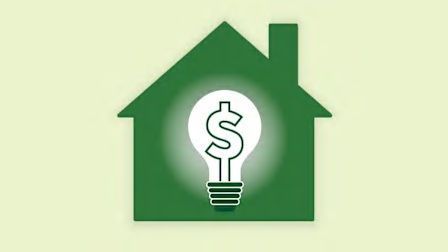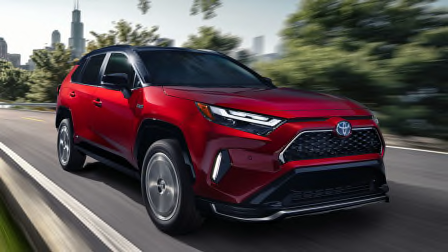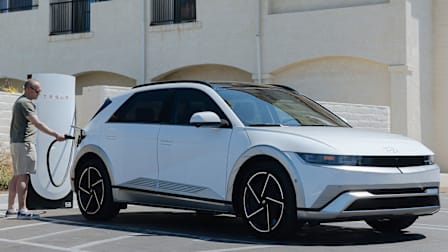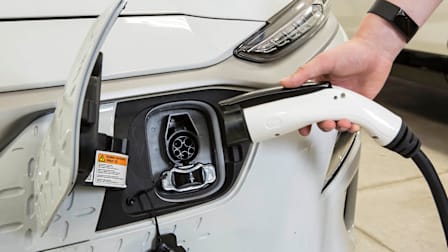Using Public Chargers for Your Electric Vehicle? Here’s How to Get the Best Deal.
It can be difficult to compare the price of a charge from one public charging station to the next–and prices can vary a lot. Here’s what electric vehicle owners need to know to save money when they can’t charge at home.
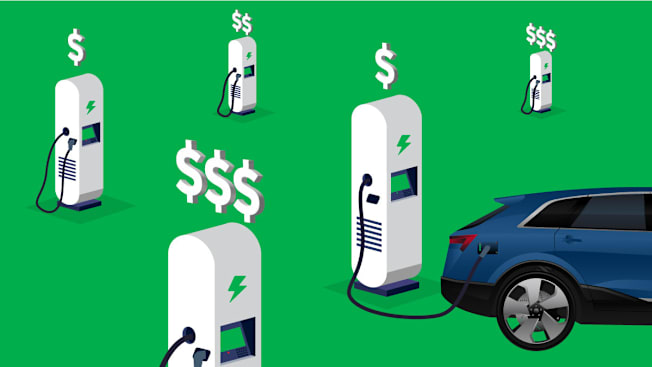
While the Oak Park River Forest High School Huskies have never taken on the Tigers of Elmwood Park High School “Friday Night Lights”-style on the football field, the two neighboring suburban communities outside Chicago are rivals for the business of electric vehicle (EV) drivers.
That’s because both towns have a pair of Level 2 EV chargers that are available for the public to use, Elmwood Park’s at its fire station and Oak Park’s at the main library. Like the kind of public chargers often found at shopping malls and parking garages, these 240-volt Level 2 chargers are capable of adding 20 to 30 miles of charge per hour, calculating the cost by the kilowatt hour. But in Elmwood Park, a 2-hour charging session will set you back $2.53, while at Oak Park the cost is $4.59—or a staggering 81 percent more.
Drivers of internal combustion engine (ICE) vehicles would be hard-pressed to find such a big price difference at gas stations within a 2-mile radius. And yet what’s playing out pricewise in Elmwood Park and Oak Park has been observed all over the country wherever public EV charging is available.
There are multiple reasons why the price of EV charging can vary so much. But the end effect is a big problem for consumers. “It can be really hard to know where to go if you want to get the best price when charging your EV at a public facility,” says Drew Toher, sustainability campaign manager at Consumer Reports, who led our first-of-its-kind analysis of retail store EV charging infrastructure across the U.S.
Charging Networks By The Numbers
No Place Like Home
According to the Department of Energy, most EV owners do a majority of their charging at home. But not everyone who would like to own an EV has access to a driveway or garage. The Bipartisan Infrastructure Law that President Joe Biden signed in to law in 2021 allocated $7.5 billion to build out a network of public EV chargers across the U.S., with the intention of installing 500,000 chargers by 2030. (To date, there are more than 168,000 public chargers here.) But to encourage consumers to buy EVs, it’s important to make more chargers available and give consumers clear expectations about what refueling might cost.
“Consumers have every right to expect clear and visible pricing when they go to fuel their vehicle,” Toher says. “This is an important issue for the industry to tackle if they want to win over renters, apartment dwellers, and others who won’t have access to home charging as they think about switching out their older gas car for an EV.”
“Being a retail consumer of EV charging is a giant pain,” says Andrea Marpillero-Colomina, PhD, sustainable communities program director for the environmental justice nonprofit GreenLatinos. If the consumer experience doesn’t become easier, both in terms of the availability of public charging and the clarity of pricing for it, people without access to home charging, including many of those in under-resourced communities of color, won’t be able to reap the benefits of cleaner transportation and lower energy costs, she says.
What to Do
If you’re considering buying an EV, CR’s EV buying guide is a comprehensive resource. Among other things, it can help you calculate the cost of charging a vehicle at home and away based on the type of charger you use and the kWh electricity rate. But when home charging isn’t an option, here are some additional tips to make the process more convenient and less costly.
Use apps to find charging stations and shop based on price. Each of the charging networks has an app that helps you find in-network chargers compatible with the type of charging connector you need, information you provide when you sign up to use them. Many will also tell you if the charger is currently being used and will let you pay for the session through the app. (In some cases, you can also pay with a credit card or mobile wallet at the station itself.) With the Blink mobile app, for instance, you can search for charging stations by ZIP code or address, see their availability, and, once you’re hooked up, receive live updates about your vehicle’s percentage of battery charge.
ChargeHub and PlugShare, apps unaffiliated with any charging network, can help you find chargers across networks by location, providing cost estimates.
Google Maps also has a tool to help you find EV chargers. In Google Maps, tap your profile icon in the search bar and select settings, scroll down and select “electric vehicle settings,” then choose your vehicle’s connector type. Maps will then share the location of chargers compatible with your vehicle.
Find free charging: At least one major retailer, Macy’s, offers free Level 2 charging as an amenity in the parking lots of some of its locations. You can also find free chargers at Cinemark movie theaters and at some parking garages (though you may have to pay to park). The apps of at least two charging networks also have filters to help you find chargers in their networks that are free to use.
Become a member. Several of the companies that make and maintain chargers offer subscription services that allow you to pay a monthly fee for discounted use of chargers in their network. For example, for a $7-a-month subscription, Electrify America, with its more than 950 stations across 47 states, the District of Columbia, and five provinces in Canada, says users can save about 25 percent on charging. EVgo operates across more than 35 states and has a three-tiered subscription model for its 1,000 plus charging locations, with monthly prices ranging from 99 cents to $12.99. It claims that users at the highest membership level can save up to 30 percent each month.
Consider peer-to-peer charging. Depending on where you live, you may be able to book a charging session at the private home of someone who has a charger available. EVmatch, a company that might be described as the Airbnb of EV charging, has a platform that homeowners with chargers can list themselves on. After agreeing to the price (homeowners typically mark up the cost of the electricity by about 20 percent), EV drivers can book a session. Heather Hochrein, EVmatch’s founder and CEO, says she launched the service to support drivers without home charging access. It operates across the U.S.
Don’t dawdle. With EV charging, time is money. Avoid added expenses by disconnecting as soon as possible after your vehicle is sufficiently charged. After a 10-minute grace period, Electrify America charges 40 cents a minute for cars that don’t disconnect. Tesla charges 50 cents a minute, which doubles to $1 when the station is at 100 percent capacity. Pro Tip: If the vehicle is moved within 5 minutes, the fee is waived.
Decline DC. Unless you’re on a road trip and need to get a full charge quickly, opt for slower Level 2 chargers, which can be cheaper, if not free (see above). In the U.S., there are more than three times as many public Level 2 chargers as DC fast chargers. (See CR’s real-world take, “Can Electric Vehicle Owners Rely on DC Fast Charging?”)
Advocate for chargers at work. Employers may be persuaded to install free chargers in the company parking lot if enough employees ask for them. The U.S. Office of Energy Efficiency and Renewable Energy’s Workplace Charging Employer Workshop Toolkit can assist you.

















